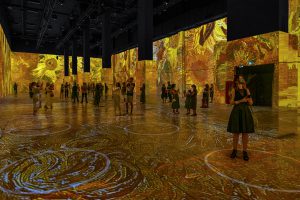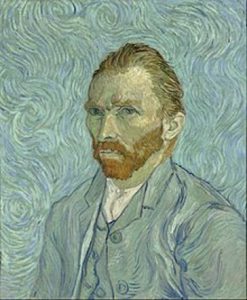
Trend View by Brad Balfour
Though there’s no permanent installation in the United States devoted to the immersive art experience, there are several shows in this country extolling a mythic version of Dutch-born painter Vincent Van Gogh. Ironic too, since he was an obscure figure when alive, little appreciated until well after his suicide at 37 on July 29th, 1890.
The Immersive Van Gogh Exhibit New York was pretty impressive for all its limitations. Located at Pier 36th in lower Manhattan off South Street, even the excursion to its location was an adventure in and of itself. And I hadn’t even stepped inside the hall.
The show at the Pier offered three large rooms running one or another sequence of the visuals which ran under and hour. One room had floor-to-ceiling projections and provided the most hallucinogenic experience. The filmic images weren’t there so much for historical information but to act as an attempt to get inside Van Gogh’s head and art.
The other NYC show, Van Gogh: The Immersive Experience, hasn’t yet stirred me enough to see it. Though it offers some different features such as a Van Gogh VR show, I’ve not been motivated so far. Though it’s easier to get to — being that it’s at Spring Studios in Tribeca — I’m not yet prompted to get down there.
Nonetheless, these shows and others that have been springing up here, in Los Angeles and other cities across the globe reflect a growing trend.
In Paris, France, a huge space, L’Atelier des Lumière, uses 140 video projectors and a surround-sound system, to present a unique multimedia experience. The Atelier des Lumières has two areas for visitors: La Halle and Le Studio. The areas rotate continuous cycle of digital exhibitions that are projected, alternating between a long program, devoted to the great figures in the history of art such as Van Gogh, and a short, more contemporary program.
Though this isn’t meant to displace the traditional museum-going experience of viewing art on walls, the idea is to create engaging and entertaining experiences that physically affects audiences while dazzling them visually and aurally. Original works are getting created for this experience and have been over the years but not to such extent as they are now — with new technology, and audiences conditioned to such events.
The Blueman Group and Cirque d’soliel have developed visually stimulating shows that are more experiential. For certain presentations which have a narrative thread, productions can be developed out of films or theatrical productions. These art creations can be original works from living established artists, emerging artists, collectives, co-creators or be reinterpretations of classic artists and their works.
I’d like to see other notable artists whose works have become iconic such as Romare Bearden, Salvador Dali or Alexander Calder transformed in a similar way. Some exhibitions of established, living artists such as Kenny Scharf, Ron English or Swoon could work as well in this way.
However meager the Van Gogh experience might be at this point, it suggests the future of experiencing art. The focus on art created by new technologies through light-generation or drone-infused art, virtual reality or augmented reality are getting made by a diverse community of artists. These creators have tools and specialists trained in the most innovative technologies who can create unforgettable experiences. And with the work being made, they are all also creating new ways to experience it.
